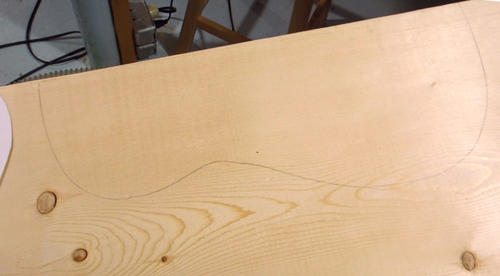
The sound board for instruments is typically made of spruce. Spruce is used because it's strong yet very light so it transmits sound more easily.
I bought a piece of 2x8 lumber at the Home Depot for my sound board. I looked through the stack of wood until I found a piece from which a nice soundboard could be cut out, with the grain mostly perpendicular to the surface, similar to quarter sawn wood.
 The growth rings were about 1mm thick on average.
The growth rings were about 1mm thick on average.
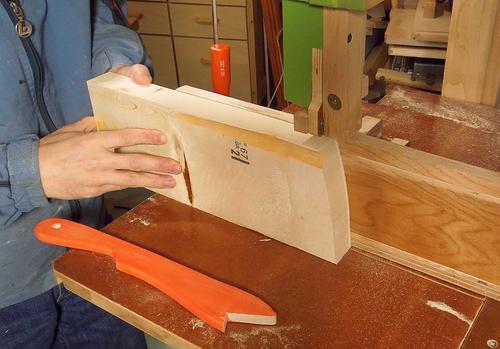
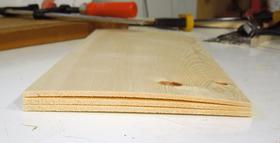 I cut layers of veneer off my workpiece on the bandsaw.
I cut layers of veneer off my workpiece on the bandsaw.
The first layer I cut had quite a bow to it. The kiln drying process often leaves stresses in the wood. Fortunately, the next two layers were much flatter, so I used those.
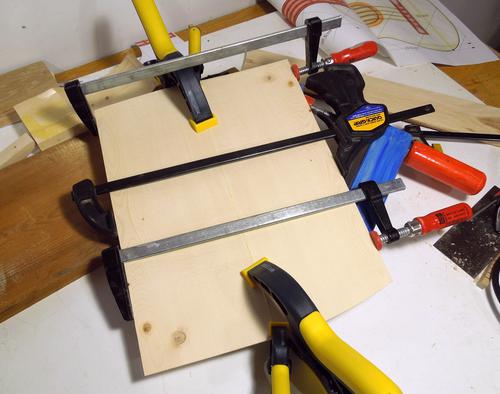 I glued the 3 mm thick rough sawn pieces together edge to edge.
I used some spring clamps to keep the edges aligned.
I glued the 3 mm thick rough sawn pieces together edge to edge.
I used some spring clamps to keep the edges aligned.
This sort of job just screams "build a jig", but I'm not planning on getting into guitar building, so I wouldn't have much use for such a jig after this build. I didn't at the time know the trick of using strings and cauls, like Pat Hawley uses , although that trick seems a bit awkward too.
 Next I had to get the piece down to its final thickness of 2 mm.
I cut the thickness from the edges on my table saw.
Next I had to get the piece down to its final thickness of 2 mm.
I cut the thickness from the edges on my table saw.
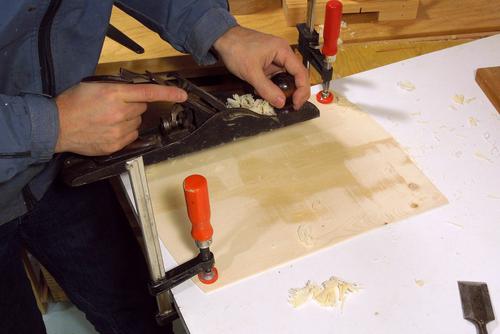 I flattened the middle part, which I couldn't reach with the table saw
with a hand plane.
I flattened the middle part, which I couldn't reach with the table saw
with a hand plane.
Traditionally, a thickness sander is used to bring such thin material down to its final thickness, but I don't have a thickness sander, and I don't really want to build or buy one either. This method worked ok for a one-off.
But if I wanted to become a luthier, I'd definitely get a thickness sander.
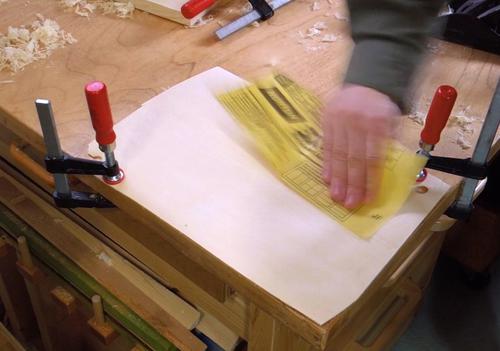 Finally, I hand sanded the surface with 400 grit sandpaper.
Finally, I hand sanded the surface with 400 grit sandpaper.
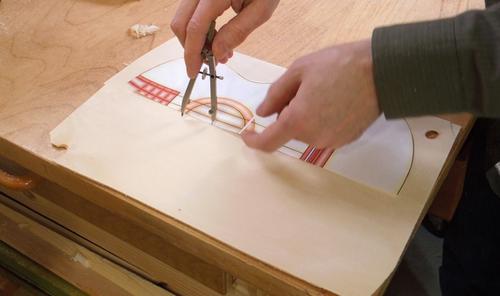
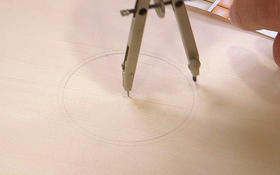 I used my 1:1 printout to figure out where the sound hole should go and
marked it with a compass.
I used my 1:1 printout to figure out where the sound hole should go and
marked it with a compass.
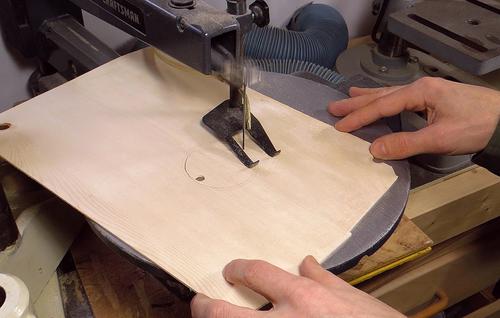 I cut the sound hole with my scroll saw.
I cut the sound hole with my scroll saw.
For fancy guitars, with a rosette around the sound hole, both the groove for the rosette inlay and the hole itself would be cut with a router jig.
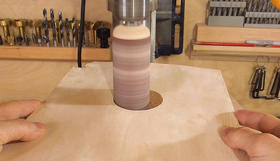 I used a spindle sander attachment in my drill press to clean the edges
of the hole.
I used a spindle sander attachment in my drill press to clean the edges
of the hole.
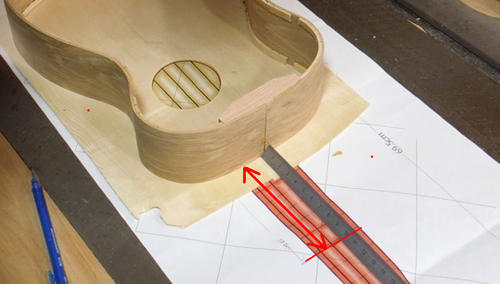 With the sound hole cut out, I used my 1:1 printout to locate where the body fits on the
sound board. I made a mark 10 cm from the edge of the body on the printout, then aligned
my sound board hole with that on the printout and measured back the 10 cm to place the body
(see arrows in red).
With the sound hole cut out, I used my 1:1 printout to locate where the body fits on the
sound board. I made a mark 10 cm from the edge of the body on the printout, then aligned
my sound board hole with that on the printout and measured back the 10 cm to place the body
(see arrows in red).
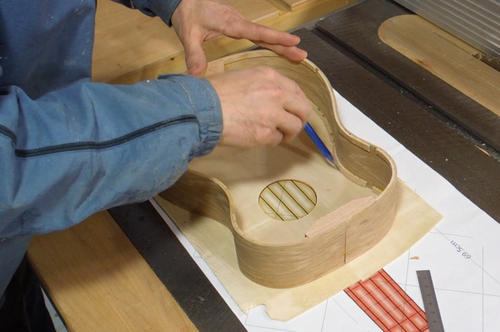 With the ukulele body center line aligned with the glue line on the sound board, I
traced the inside and outside edge of the body on the sound board.
With the ukulele body center line aligned with the glue line on the sound board, I
traced the inside and outside edge of the body on the sound board.
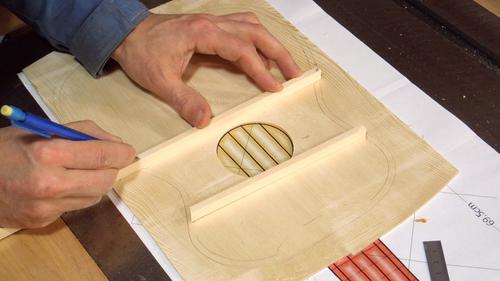
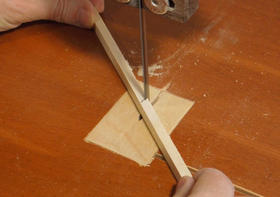 Preparing the ribs. Here I'm marking where the ribs need to be cut to extend to the
gaps in the lining of the body.
Preparing the ribs. Here I'm marking where the ribs need to be cut to extend to the
gaps in the lining of the body.
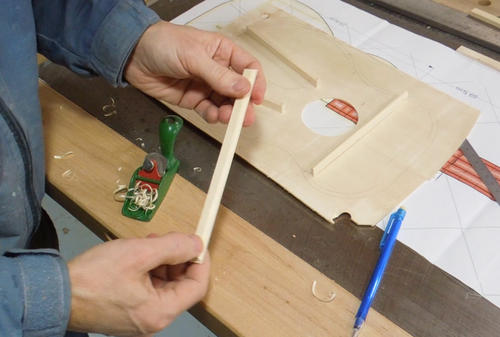 The top side (facing away from the soundboard) of the ribs is typically rounded. I neglected
to cut the profile into the ribs beforehand, but this had the advantage that I can leave
the locations where the ribs join all square for more contact area.
The top side (facing away from the soundboard) of the ribs is typically rounded. I neglected
to cut the profile into the ribs beforehand, but this had the advantage that I can leave
the locations where the ribs join all square for more contact area.
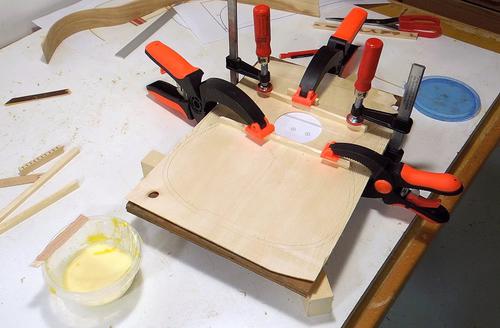 I put the sound board on a piece of plywood, then used clamps to press the ribs onto the
sound board while the glue dried.
I put the sound board on a piece of plywood, then used clamps to press the ribs onto the
sound board while the glue dried.
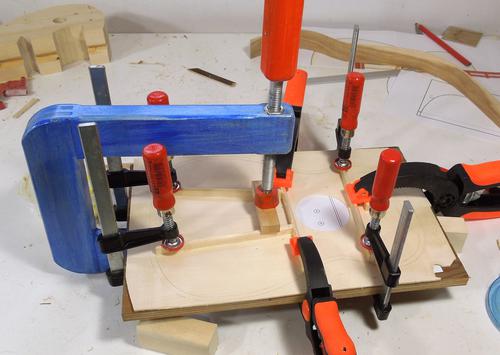 Last two ribs glued on. My long reach clamps came in handy
from time to time.
Last two ribs glued on. My long reach clamps came in handy
from time to time.
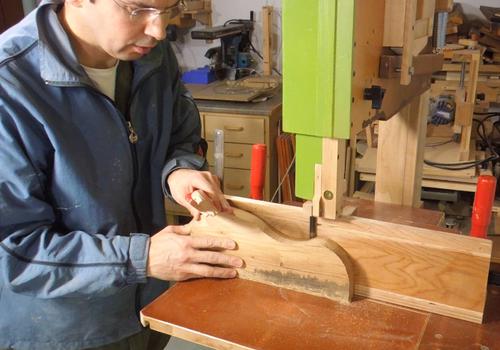 Resawing the wood to form the back of the ukulele. The back is usually made
of the same type of wood as the sides. In my case, white oak.
Resawing the wood to form the back of the ukulele. The back is usually made
of the same type of wood as the sides. In my case, white oak.
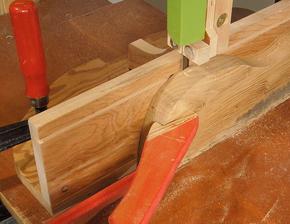 I pre-cut the approximate profile of the back out of my block of wood to make the
resawing faster.
I pre-cut the approximate profile of the back out of my block of wood to make the
resawing faster.
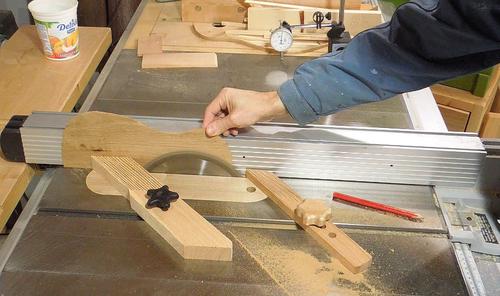 I thinned the two halves to 2 mm on my table saw, taking off
no more than 0.5 mm at a time. I was able to cover the whole surface
by cutting from both sides.
I thinned the two halves to 2 mm on my table saw, taking off
no more than 0.5 mm at a time. I was able to cover the whole surface
by cutting from both sides.
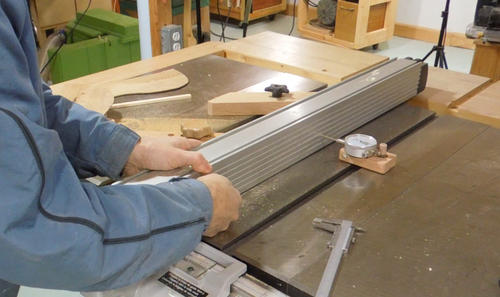
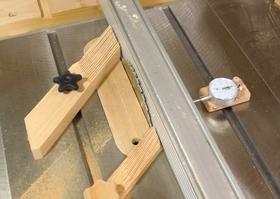 On checking the thickness, I adjust the fence, using a dial indicator to
check how much I moved it.
On checking the thickness, I adjust the fence, using a dial indicator to
check how much I moved it.
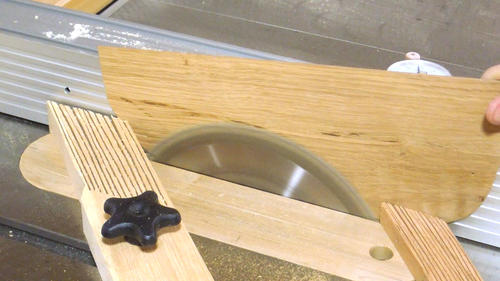 It's important to make this sort of cut in one continuous motion.
It's important to make this sort of cut in one continuous motion.
I initially pushed the piece with my push sticks, but found I often slipped off the workpiece with them. Wherever I stopped even briefly, the spinning blade caused burn marks on the wood.
So I resorted to pushing it by hand. I kept most of my hand over the fence, with just my fingers extending past the fence, so that if some mishap were to occur, my hand would not get pulled down to the blade.
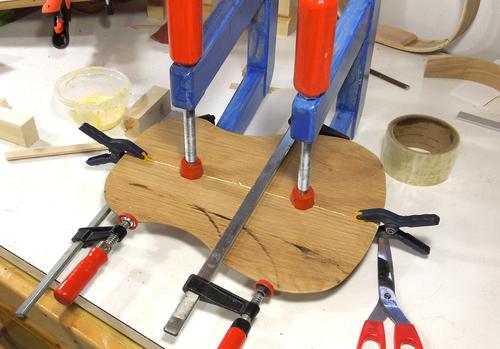 Gluing the 2 mm thick back pieces together.
Gluing the 2 mm thick back pieces together.
After gluing, I used a cabinet scraper to smooth it out and remove some of the saw marks.
I also added some flat slats between the main ribs to help hold the back together. My main concern is that the back may crack due to changes in humidity, and I figure the extra slats will make that less likely.
It was actually tempting to just make the back out of 2 or 3 mm thick plywood. The back is not critical for sound, and there's no risk of cracking with plywood. But making it out of the same wood as the sides looks much better.
See also: Pat making the sound board
Next: Assembling the body
To my ukulele page
![]()